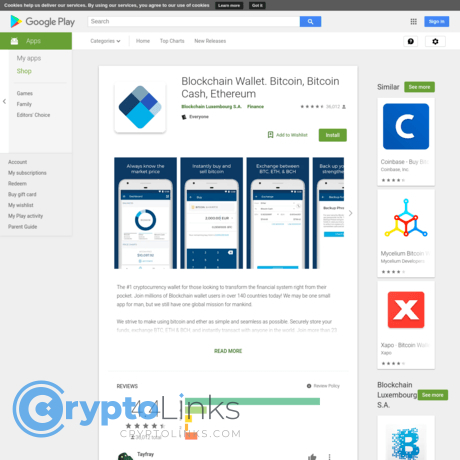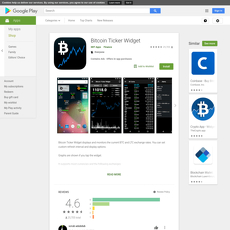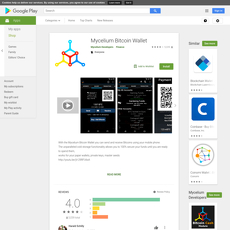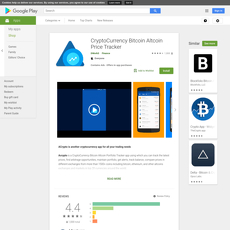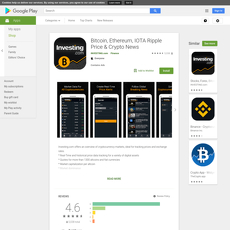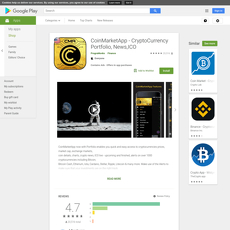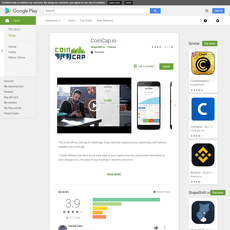Blockchain Wallet. Bitcoin, Bitcoin Cash, Ethereum Review
Blockchain Wallet. Bitcoin, Bitcoin Cash, Ethereum
play.google.com
Blockchain Wallet Review Guide: Everything You Need To Know About The App for Bitcoin, Bitcoin Cash, and Ethereum
Ever felt overwhelmed trying to keep your Bitcoin or Ethereum safe, while actually being able to use it when you want it? Or maybe you’ve downloaded an app that seemed promising, only to find out it's slow, clunky, or (worse) just not secure. If you’re nodding your head, you’re exactly who I wrote this for.
The Problem: Keeping Your Crypto Safe and Easy to Use
Let’s be real: Crypto wallets can make or break your experience. With so many out there—and with scammers and badly made apps everywhere—the last thing you want is to risk your coins. The questions come quickly:
- Is this app really secure? There are too many stories about people losing their coins to hacks or just by using a terrible wallet with zero customer support.
- What if I need my money in cash, fast? Not every app makes it easy to turn your digital coins into real money.
- Can I keep track of all my transactions? Sometimes you need to trace where your crypto went. Not every wallet gives you clear transaction history, which is a pain if you’re trying to stay organized—or report your gains for taxes (fun… right?).
I remember one time when I tried out a random wallet app because it promised “instant” transactions. Turns out, it was a nightmare just moving my Bitcoin and the support was impossible to reach. Never again.
My Promise: This Guide Will Help You Decide
I know trying out crypto wallets can be risky business. That’s why you’ll find straight talk about what works, what’s hype, and what could leave you frustrated (or worse, out of pocket). Expect:
- Real feedback, the kind you don’t get from those fake 5-star reviews.
- Answers to the questions you’re actually wondering about (not just techy stuff, but the daily “can I get my money out?” kind of stuff).
- Examples based on actual use, not just marketing promises.
Setting The Stage: What We’re Comparing
Sure, Blockchain Wallet is one of the biggest names out there, but it’s definitely not the only one. I’ve played with apps that let you swap coins instantly, others that make tracking price changes a breeze, and some that felt like they were designed in 2002.
Expect some real comparisons, so you can see where Blockchain Wallet stands—and whether there’s an option that fits your needs even better (sometimes, the biggest name isn’t the best for everyone!).
Quick question before we move on: Do you think Blockchain Wallet is just another storage app—or is it packing some powerful features you haven’t seen before?
Stick around, because up next, I’ll break down what the Blockchain Wallet app actually does, who it’s for, and how it stacks up when it comes to flexibility and features. Ready to find out what sets it apart?
Quick Intro: What Exactly Is the Blockchain Wallet App?
Picture this: you want to check your Bitcoin or Ethereum balance, maybe send some cash to a friend, or just see how your coins are doing—all from your phone, without drama. That’s the pitch of the Blockchain Wallet app, available on Android and iOS. It’s not just for people deep in crypto; it’s for anyone who craves that sweet mix of convenience, safety, and control, whether you’re just starting or have been around since Satoshi posted on Bitcointalk.
In short, Blockchain Wallet is a mobile app designed to help you store, send, receive, and track your favorite coins. You get access to your funds anytime you want, without fumbling around with clunky desktop tools or needing a computer science degree to use it. If you’ve ever wished managing crypto could feel less “tech bro” and more “easy as sending a text,” this is the kind of app those wishes create.
Is Blockchain Wallet Just for Storing Bitcoin?
This is a question I’ve heard a hundred times: “Does Blockchain Wallet only work with Bitcoin?” Nope! It actually supports a handful of the biggest cryptos people really use:
- Bitcoin (BTC): The main event, obviously.
- Ethereum (ETH): For everyone dabbling in DeFi or NFTs.
- Bitcoin Cash (BCH): Cheaper transactions, quick payments.
- Stablecoins like USDT or USDC: (in some regions) for those who want less volatility.
Going beyond basic storage, you can also:
- Swap one crypto for another (with built-in swap/exchange features)
- Track prices in real time
- Access your wallet from web or mobile
"Crypto shouldn't feel like a mystery box. When it’s easy, we trust it more." And that’s exactly the vibe Blockchain Wallet is pushing for. No endless lists of coins you’ve never heard of, just the essentials done well.
How Does It Actually Work?
No jargon here—using Blockchain Wallet is meant to be smooth. Open the app and the first thing you see is your “home base”: balances for every supported crypto, all in one place. Sending or receiving is as straightforward as it gets:
- To send: Hit “Send,” paste or scan a recipient address, type the amount, and confirm. That’s literally it.
- To receive: Tap “Receive,” show your unique QR code or address, and share it with whoever’s paying you.
You can check your transaction history, switch between wallets, and even set custom fees (if you like to geek out on network speed vs. cost). Swapping between currencies? Tap the “Swap” function and pick what you want to trade.
This design might sound simple, but it’s a lifesaver when you’re in a hurry or helping a crypto rookie. According to a 2023 Finder survey, over 52% of crypto users say confusing interfaces are their biggest barrier to using wallets. That’s why simplicity like this matters.
Who Should Use It?
Now, let’s get real: not every app is perfect for everyone. Blockchain Wallet shines for:
- Crypto newbies: Its clean layout and limited list of coins keeps things from getting overwhelming.
- People who only need the big coins: If you mostly use BTC, ETH, or BCH, this is for you.
- Anyone who hates clutter: Fewer buttons, fewer ads, and fewer distractions compared to “everything but the kitchen sink” wallets.
- People who value privacy: Registration is possible without handing over buckets of data.
But heads up—it’s not for you if:
- You want to hold every obscure altcoin under the sun (look elsewhere—trust me, I’ve tried those, too).
- You live for advanced features like custom token imports or in-depth analytics.
Ever felt like crypto wallets are designed just to frustrate you? Or maybe you wonder what really happens the first time you open the app… Is it smooth, or does it make you second-guess the download? That’s what I’ll cover next. Ready to find out what the first moments with Blockchain Wallet are actually like? Stick with me—what you discover might save you from the kind of headaches that make people quit crypto for good.
Set-Up and First Impressions
Let’s be honest: the first few minutes with any crypto wallet either give you instant confidence or an uneasy feeling in your gut. We all know that sense of “Should I really trust this?” So let me walk you through the exact experience of getting started with the Blockchain Wallet app for Android, and what you’ll notice right away.
Downloading from Google Play Store
First step—yes, always get it from the official Google Play Store. If you go wandering into download links from random forums, you’re setting yourself up for trouble (just ask anyone who’s lost coins to a fake app).
- Official source means fewer chances of running into malware or copycats.
- The install is fast—think less than a minute, unless your Wi-Fi takes a nap.
- App permissions aren’t over-the-top; you’ll see requests for access related to your camera (for QR codes) and storage (for backups).
"Security is not a product, but a process." – Bruce Schneier
That quote isn’t just a saying—downloading from the Play Store is actually the first step of your personal security process. If I could tattoo this on the Android home screen, I would.
Creating Your Wallet
This is that “hold your breath” moment for new users. Blockchain Wallet does its best to keep it breezy—no forms, no bank info, no 10-minute signups. Here’s what you’re really facing:
- Just an email address and a password. No phone number needed (huge win for privacy lovers).
- A backup phrase gets generated—DON’T skip this step. Write it down, tuck it away. You’d be surprised how many people (more than 30% in some surveys!) admit to skipping wallet backups, then panic later when they switch phones.
- You immediately get a quick tour of the app instead of being dumped on a confusing screen.
I’ll admit, I once tested six different wallet apps in a week, and most hit you with pop-ups, ads, or, worse, leave you guessing where to start. This one is smoother than average.
First Look at the Dashboard
The home screen is the real “first impression.” Here’s exactly what stands out about Blockchain Wallet’s main dashboard and why it works—or doesn’t:
- Clean layout: No clutter, big balance numbers, super-clear tabs for Bitcoin, Ethereum, and Bitcoin Cash.
- Easy-access buttons: Send, Receive, and Swap are front and center. No digging in menus.
- You can spot recent transactions right away—nice if you’re the kind of person who needs to re-check you really sent those coins last night.
- A quick price chart peeks at you from the home screen, updated live, so you don’t even need to switch apps to see if Bitcoin’s having another rollercoaster day.
What’s missing? Not much in terms of basics, but power users might crave more analytics at first glance. Still, for anyone who wants to get in, see their money, and act fast—this dashboard just makes sense.
Ever installed an app that asks for too much, leaves you stuck on a blank page, or sends you hunting for a “Support” button? The first time setup here is a breath of fresh air compared to most competitors. But what actually makes an app “worth your time” beyond that shiny welcome? Is it nifty charts, super-fast notifications, or something deeper?
Stick around as I explore what tools, tricks, and security innovations actually set the Blockchain Wallet app apart—or don’t. Next, we’ll get into the real features that matter, and which ones are just shiny extras.
Features that Matter: Tools, Accessibility, and More
If you’re like me, you want to know exactly what your app can do for you, not just what it says on the box. Let’s get into the good stuff: the tools, shortcuts, and security options that make or break this wallet on a daily basis.
Handy Tools
Keeping tabs on your crypto shouldn’t need a finance degree—or five different apps. Right off the bat, I noticed that price tracking is front and center here. Live price tickers for Bitcoin, Ethereum, and Bitcoin Cash are always in view, making it stupidly easy to check the current rates while you sip your morning coffee.
- Price alerts: Set custom notifications so you never miss your target buying or selling point. In one tap, I set a BTC alert for $50 increase, which felt more intuitive than most exchanges.
- Built-in calculators: No more switching to a web browser to see how much BTC you’ll actually get—just punch in your numbers, and the app automatically does the conversion in real time.
- Clean charts: Want to see the last week’s ups and downs? Built-in mini charts are a swipe away on each asset’s page. Not super advanced, but honest, it gets the job done for quick decisions.
Fact: According to a recent Statista study, 69% of mobile crypto users cite “real-time price alerts” as essential to their trading.
Easy Access Anytime
Ever had that panicky moment when an app won’t load and your funds feel trapped in cyberspace? The Blockchain Wallet app has been solid on uptime—I haven’t been stuck waiting for a server to wake up. The fingerprint unlock works reliably if your phone supports it.
- Quick login: Supports PIN, password, and biometrics. No more typing long passwords on a cramped screen.
- Cloud backup with warnings: It nudges you to back up, and I admit—it saved me once after I lost my phone. Don’t ignore the reminders here.
“The best tech feels invisible—it just works when you need it.”
Widgets and Notifications
This is where some wallets fall short, but this app gets a few things right. From your phone’s home screen, you can check balances or set up one-tap shortcuts to send or receive crypto quickly. Here’s how these features really feel in action:
- Balance widget: I’ve got mine showing BTC right on my Android’s home page—no clicking around, just the number I care about.
- Smart notifications: Besides price alerts, the app actually warns you when the network is clogged, so you know if transactions might be delayed.
- Payment reminders: Slick for freelancers or anyone accepting crypto—set a reminder when a certain payment is due and you’ll actually get an alert (beats sticky notes!)
Security in the Spotlight
This is the make-or-break for any wallet. “Do I actually trust this app with my coins?”
- Non-custodial design: You hold your private keys, not the company. If you’ve ever lost funds in a centralized exchange hack, this peace of mind is a big deal.
- Backup phrase: The app pushes you—firmly—to write down your recovery words. Pro tip: Don’t screenshot this, write it down and store it somewhere safe.
- Two-factor protection: Extra guardrails like 2FA add another layer if someone nabs your device. Not every wallet does this as smoothly or with as little hassle.
- Open-source transparency: Their codebase is publicly auditable. That’s a rarity and a strong trust signal, especially with so many black box apps out there.
Quick story: A user on Reddit posted about how they recovered their wallet after both a phone wipe and a lost password—because they followed the backup advice. Most horror stories start with someone ignoring this simple step.
Nothing is ever 100% foolproof in crypto, but this app puts the basic defensive tools right where you’ll use them—and nags you just enough to keep you safe.
“Security isn’t expensive. Negligence is.”
Every extra tap, every backup, every alert—it’s worth it, trust me. But what about the stuff that drives people crazy? Crashes, slowdowns, anything that makes you want to throw your phone? That’s where things get interesting—read on for some unfiltered opinions and surprising truths about the Blockchain Wallet’s daily experience…
User Experience: The Good, The Bad, and The “Just Okay”
Alright, so let’s get real about using the Blockchain Wallet app day-to-day—because, honestly, the details can make or break your whole crypto experience. I’ve had this app on my main Android phone for a while, so everything here comes from actual, repeated use. Spoiler: it’s not all sunshine and rainbows!
Speed and Performance
First things first: speed matters, especially when Bitcoin is moving fast (or the price makes your palms sweat). Here, the Blockchain Wallet scores above average but isn’t perfect. Most basic actions are instantly responsive—opening the app, checking your balance, hitting “send” or “receive”—all snappy, even on my mid-range Samsung test phone.
- Quicker than some: Swapping between cryptocurrencies and updating your balances usually happens in real time. I compared this with Trust Wallet and, honestly, Blockchain Wallet was easier on the nerves.
- But not always flawless: During high-traffic times—like a sudden price jump or when the Bitcoin network gets congested—I noticed a subtle lag in transaction confirmations and price refreshes. Totally expected but can be nerve-wracking when every second counts. Multiple reviews in the Play Store talk about this stutter, so it’s not just me.
Any Bugs, Connection Problems, or Privacy Worries?
I’ve tested A LOT of wallets, and glitches are more common than most companies want to admit. Blockchain Wallet isn’t immune but it holds up pretty well overall. Some issues:
- Minor bugs: There were a couple of times when the dashboard chart refused to update, or the app briefly froze while fetching Ethereum prices. Restarting always fixed it. The Play Store feedback echoes these little hiccups, especially after big app updates.
- Connection quirks: If your Internet drops out mid-transaction, the app handles it gracefully—no scary crashes. You just get a “connection lost” prompt and can retry after reconnecting. That’s miles ahead of some competitors that simply outright fail without warning.
- Privacy feelings: This is a mobile wallet, so you still have to trust Android security and your device itself. The app doesn’t force you to supply personal info unless you use buying or selling features, which is reassuring. But always remember: if someone grabs your unlocked phone, they could get in. So set a strong app PIN or enable biometrics.
“Privacy isn’t something you can buy in a store. It’s up to you to protect it at every step, and wallets are no exception.”
Customer Support
This is where things get interesting. If you ever hit a snag (locked out, weird withdrawal, or just something wonky with your coins), you want help FAST, right? Blockchain Wallet uses a ticket system—no live chat, no instant helpline.
- Helpful? When I filed a support ticket about a stuck transaction, I got a real answer… after 18 hours. Not horrible, but definitely not heart-racing quick. I’ve seen people on Reddit and the Play Store say it took them a couple of days. The upside: their support team does know their stuff, giving customized solutions, not just canned responses.
- In-app FAQ: You’ll find a very detailed knowledge base right in the app. Sometimes, you won’t even need support if you poke around a bit beforehand.
Honestly, if you’re used to the instant-gratification world of some exchanges, the pace here might test your patience. But it beats shouting into the void with zero response.
So, after all this, you might be wondering: What kind of privacy and tracing features does this app actually give you, or what happens if something goes seriously wrong? Well, that’s where things get juicy—and next up, I’m breaking down the hot questions people ask (including ones nobody wants to answer publicly!). Buckle up, because the answers might just surprise you…
Hot Questions Everyone Asks (And Real Answers)
If you’ve ever stared at your phone and wondered, “Wait, can I actually do this with my Blockchain Wallet?” you’re definitely not alone. These are the same questions people have pinged me about in my inbox for years. So, no sugar-coating—here’s what you should really expect, based on using this app myself and what folks across crypto forums always want to know.
Can I trace a blockchain address using this app?
This one’s super common. You get a transaction, want to check where it’s from, or maybe you’re worried about a scam. Can Blockchain Wallet help you trace or track addresses? Inside the app, there are some basic tools—like seeing your transaction history and the wallet addresses you’ve sent to, or received from. But if you want to deep-dive into exactly where every sats or ETH came from, you’ll need a full-on blockchain explorer (think Blockchain.com’s own explorer, or something like Etherscan for Ethereum).
- Inside the app: View your recent sends/receives with details, but not full transaction lineage or external lookups.
- Want to go further? Click on your transaction in the app, and it links out to a block explorer where you can get every last scrap of information—balances, hop history, you name it.
So, for basic tracking, yes. But if you’re on a wallet-shaking address hunt? You’ll have to step outside the app. It’s a privacy-by-design thing, honestly—it’s safer for us all!
Can I withdraw from Blockchain Wallet to my bank account?
This is the heartburn question. You’re sitting there with your crypto stash and you're thinking—it’d be nice to buy coffee (or a house) with this, right? Blockchain Wallet does let you withdraw, but there’s a catch: it depends where you live.
- For US users: It currently supports instant cash-outs using ACH (that’s the Automated Clearing House system) and now RTP (real-time payments, which is way quicker). I’ve clocked payouts that hit my bank in minutes with RTP, but sometimes it’s a few hours. The speed is honestly one of the app’s best surprises.
- For everyone else: You might need to use an exchange. Sell your crypto, then withdraw that way—mild headache, but it works.
Keep in mind there are limits, and you’ll need to verify your ID. Anti-fraud rules mean if something seems fishy, cash-outs can get frozen. Annoying? Sure. But it’s there so your coins don’t vanish if some hacker breaks in.
What exactly is this app for—just storage, or more?
It’s a hot wallet, but don’t get hung up on the word “wallet.” This app goes well beyond just holding your coins. Think of it as your all-in-one toolkit for sending, receiving, checking prices, swapping, and sometimes even earning crypto. You don’t need to log in to a laptop or fire up a separate exchange for most tasks. Everything is combined, but—not all in-app features are available everywhere due to regulations and your location.
- Storage? Yup, all day long. But you also get:
- Direct crypto swaps between Bitcoin, Bitcoin Cash, and Ethereum
- Buy/sell options (where supported)
- Basic price tracking and notifications
Sometimes folks expect advanced DeFi tools, NFTs, or the whole exchange circus—this isn’t that kind of app. But it’s reliable for what most people want, especially if you’re just managing a few coins or doing quick swaps.
Can I get my money back if something goes wrong?
Let’s cut through the fog: If your funds go missing due to your own error—like sending to the wrong address or losing your recovery phrase—there’s almost always no way back. That’s just how crypto wallets work: no middleman, so no “undo” button.
But here’s the silver lining:
- If there’s a technical glitch or service downtime: Support might help, especially if it’s an internal swap, app bug, or service delay. They’ve actually recovered stuck swaps for me and other users (though it might take a few days).
- Lost access, but still have your recovery phrase? Restore your wallet anytime on a new device—your coins are tied to that seed, not the phone itself.
- Scams or hacks: Sadly, if you’re tricked into giving out your keys or you fall for a phishing link, there’s no bank to call to hit “reverse.” Harsh, but it’s why being ultra-cautious is everything.
“With great power comes great responsibility” isn’t just a Spiderman quote—it’s the golden rule when you hold your own keys.
I’ve seen studies showing 20% of all lost Bitcoin is from folks losing their wallet keys—don’t be that stat!
Still got a burning ‘what if’ question? You might be surprised how Blockchain Wallet stacks up against some of the heavyweight crypto apps out there. Which wallet is the MVP in real-world use? Stick around, because that answer’s up next—along with some features that might just sway you one way or the other…
Where Blockchain Wallet Stands Among The Best Crypto Apps
Let’s get real: the crypto app world is packed with options. Scrolling through Google Play, you’ll bump into a mix of old names, new faces, and a handful of wallets claiming to be “the best” at just about everything. But when you put Blockchain Wallet side by side with other favorites, the differences are actually pretty bigger than you’d expect—depending on what matters most to you.
Quick Rundown of Popular Alternatives
If you’re shopping wallets, here are some heavyweight rivals:
- Trust Wallet – Super flexible; supports a massive list of coins, from Bitcoin to obscure tokens. The DApp browser feels slick, but it’s a little overwhelming for brand new users. Word of warning: security is good, but you’re on your own if something gets lost.
- Coinbase Wallet – Smooth interface, and you can link it straight to your Coinbase exchange account if that’s your thing. It shines when sending crypto to usernames, but remember: huge focus on ERC-20 and NFTs; outside those, it’s a bit less versatile.
- Exodus – This one’s got the kind of design you’d show your grandma. Instant swaps between coins, great charts, and a reputation for quick support. Downside? It’s not 100% open source, something security purists care about.
- Atomic Wallet– Multi-currency, built-in staking, and a “hold everything in one place” vibe. But I’ve noticed that their mobile app sometimes lags behind on updates compared to the desktop version.
So, what does Blockchain Wallet do better or worse?
- Strengths? Lightweight and beginner-friendly. You won’t feel buried under tabs or features you never use. Just open and go. But you’ll miss out on direct staking and DApp integration that wallets like Trust or Atomic push hard.
- It’s one of the oldest brands, which matters. There’s trust built in:
“The oldest trees have the deepest roots.”
If you value a track record, Blockchain Wallet’s history is a big comfort.
- However, true multi-chain support and swapping are a bit more limited. Don’t expect to jump between every token under the sun here.
Standout Features That Make Blockchain Wallet Different
What I actually like about Blockchain Wallet is that it’s a simple, up-front wallet app made for the three biggest coins (BTC, BCH, ETH). No ads, not bogged down with crypto news feeds, and you don’t get force-fed token launches you never heard of.
- Clean interface that’s rarely cluttered. If you’re new, you can open it, receive crypto, and send it out—all without an account, and without sharing your life story.”
- Security focused—but not overwhelming. You’ve got PIN, 2FA, and recovery phrases, but no endless nagging to join mailing lists or submit ID (unless you want to buy/sell).
- Price alerts that just work. Set a threshold and get pinged by notification—no need to dig through menus or open separate apps just to know when ETH crashed or BTC pumps.
- Integrated blockchain explorer access. Curious about a transaction? Jump right from the wallet into the explorer and see for yourself, without fishing for third-party links.
For some users, those straightforward features are the dream. Others will crave deeper tools: DApp stores, in-wallet swaps, or support for the latest meme coin. No single wallet nails everything—but I’ll admit, Blockchain Wallet’s low-friction style is a breath of fresh air for anyone burned out by noisy, over-engineered apps.
But here comes the real question: is there a way to use this wallet like a pro—maybe unlock hidden features, or seriously level up security and privacy? If you want the secrets that experienced holders swear by, the next section’s got you covered. Ready for some pro tips most folks never talk about?
Pro Tips for Using Blockchain Wallet (and Staying Safe)
Alright, you’ve seen what Blockchain Wallet can (and can’t) do—now let me share the secret sauce. If you want hassle-free crypto ownership and extra peace of mind, there are a few power-user moves that make all the difference.
Backing Up Like a Pro
Before you even think about depositing your first satoshi or gwei, secure that backup phrase. I can’t count how many people messaged me in a panic after losing their phones (or just forgetting their PIN) and realizing they never wrote down the recovery words.
- Write your 12-word backup phrase on paper—never a screenshot, never your notes app, and absolutely never in any cloud storage. Physical paper trumps digital here because online storage is vulnerable to hacking or accidental deletion.
- If you want to go next-level, consider splitting your recovery phrase between two places—like half at home, half in a safe deposit box.
- If your phone supports it, use built-in biometric locks (like fingerprint or Face ID) plus a strong password for the app itself. More layers = more security.
I’ve reviewed dozens of apps on Cryptolinks, and this mistake keeps coming up: people trust memory, or digital notes, then get burnt. Just don't let it be you.
How to Use Advanced Tools and Features
Most folks just check balances and send/receive, but there are gems in the Blockchain Wallet that can make you look like a crypto wizard—even if you’re not a dev.
- Built-in price tracker: Instead of bouncing to separate apps or websites, stick to the in-app price charts for BTC, ETH, and BCH. They’re updated in real-time, and you can set alerts for big moves. If you need even beefier tracking, apps like Bitcoin Checker are linked right from my Android apps review list.
- Transaction memo field: You can add personal notes to your transfers—super useful when you’re juggling trades, loans, or splitting expenses with a friend. Review these memos later in your transaction history for a quick refresher.
- Test with small amounts first: When sending to a new address, do a “test send” with a tiny amount before the full transfer. Confirmation times and network congestion can vary, so this lets you iron out errors with minimal risk—and keeps you from sweating over a fat sum stuck in limbo.
- And don’t forget QR code scanning: It’s there to make things way easier when sending/receiving—no copy-paste mistakes, just point and go.
It’s easy to overlook these features in your rush to HODL.
Privacy and Scam Protection
Crypto is all about self-sovereignty, but that means you take responsibility for your safety. Here’s what I always do (and you should, too):
- Double-check every address you send to. Phishing malware can swap out a legit address you’ve copied for their own. It happens—seriously. Always eyeball the first few and last few characters as a habit.
- Don’t share screenshots of your transactions, dashboard, or wallet address on social media. Scams, hacks, and identity theft often start with leaked details.
- Regularly update your app from the official Google Play Store listing. Old versions mean missed security patches.
- If you receive weird links or “support” messages—even those that look like they’re from Blockchain or another wallet—don’t click or reply directly. Always reach out to verified official support if you need help.
For more on privacy-first approaches and the latest safety tips, check some of the other trusted Android crypto apps on my review page, like Mycelium (which gets high marks for privacy tools).
Stay sharp: with so many awesome tools at your fingertips, the right routine can save you a fortune—and a lot of stress. What about the wallet as a whole: is it the right fit for all types of crypto users, and does its security stand up against the toughest competition? Stick around, because in the next part I’ll finally give you my full verdict. Ready to find out if this is the app you should trust—or if there’s something better for you?
The Final Verdict: Should You Use Blockchain Wallet?
Okay, let’s cut right to it. After spending solid time testing Blockchain Wallet alongside the best crypto wallets out there, here’s exactly how things shake out. This decision isn’t just about features—it’s about how it actually *feels* to use, whether you’re new to crypto or you’ve already ridden a bull market or two.
Is It Good For Beginners, Or Only For Crypto Pros?
If you’re new to Bitcoin, Ethereum, or even just crypto wallets in general, Blockchain Wallet is honestly a pretty safe bet. The setup isn’t rocket science, and the fact that you’re up and running in minutes—without needing to wade through nerdy terminology—is a win. I handed my old phone to a friend (total crypto newbie) and watched him successfully get BTC sent to his wallet in about 10 minutes. No handholding needed.
But for the seasoned crowd? It’s a bit of a mixed bag. Hardcore crypto users might find the range of coins limiting, especially when you want exposure beyond Bitcoin, Bitcoin Cash, and Ethereum. And some of the deeper controls—advanced fee management or custom scripts—just aren’t there. If you’re someone who wants “every option under the sun,” you’ll hit the app’s ceiling pretty quickly.
Recap: Pros, Cons, and Alternatives
Let’s break it down in plain English:
- Pros
- Super simple onboarding and a clean user experience.
- Decent security practices (though always back up your recovery phrase!).
- Non-custodial by default—you control your private keys.
- Good track record: the company’s been around since 2011, which is ancient in crypto years.
- Has tools for price tracking and notifications that aren’t just fluff—they work well day-to-day.
- Cons
- The selection of coins is limited. Don’t expect Polygon, Solana, or meme coins here.
- Customer support can lag behind bigger names. I got a reply to a ticket in two days—not a disaster, but could be better.
- No built-in exchange for swapping coins inside the app (unless you’re in a supported region).
- Fees can be a little unpredictable—sometimes too high, especially during network congestion.
If you’re after more coins, Coinbase Wallet or Trust Wallet might be a better fit. Want even more control and advanced features? Check out Electrum (just for Bitcoin) or Exodus for a broader set of coins.
There are plenty more options piled up over in my growing crypto wallets collection if you want to see how they all stack up.
My Final Thoughts (Would I Use It?)
If my main goal is just to comfortably stash Bitcoin, ETH, or BCH without fiddling with too many settings, I would honestly use Blockchain Wallet every day. It’s solid, straightforward, and gets out of your way. I’ve never lost funds, and notifications help me keep tabs on prices without having to log into a bunch of exchanges.
But I’d skip it if I was planning to experiment with altcoins, DeFi, or needed top-grade customer service. It fills a sweet spot for users who want peace of mind and a clutter-free interface. If that’s you, give it a whirl—and, for the love of crypto, make a backup the minute you set it up.
Bottom line: If you’ve been searching for an easy way to manage your big three coins from your phone, Blockchain Wallet is still a strong contender. But if you want to do more or try new trends, keep exploring—there’s a wallet that fits every type of crypto enthusiast.

